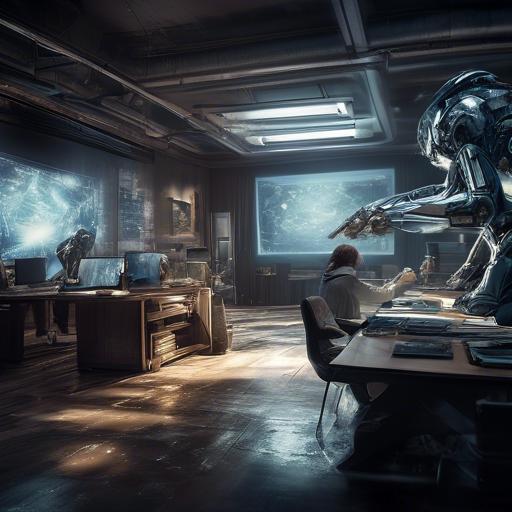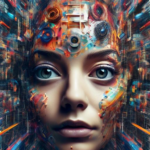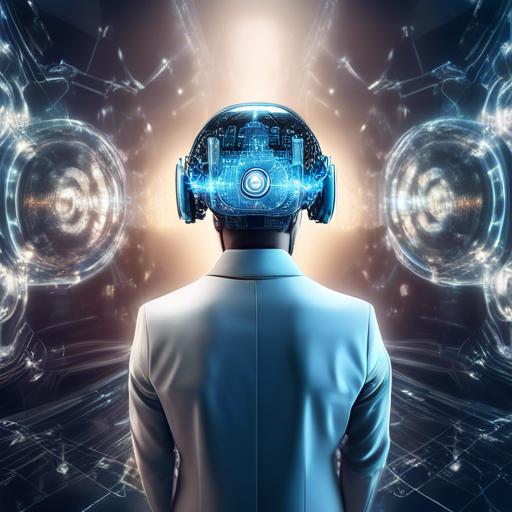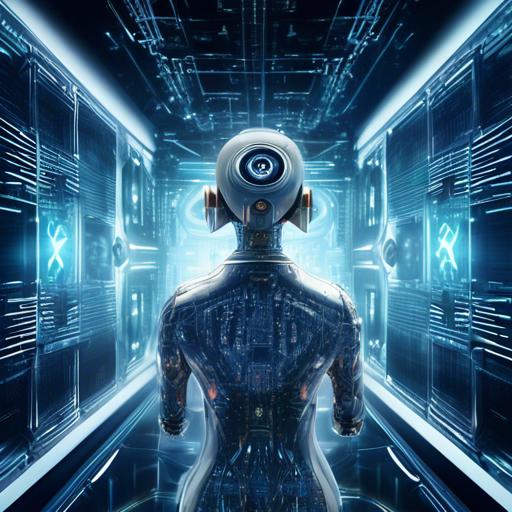In a dimly lit studio, the scratch of a pencil on paper and the soft hum of digital tablets breaching the silence are the timeless sounds of creation. For decades, concept artists and storyboard creators have toiled in these havens, bringing ethereal worlds and intricate narratives to life. Yet, as the dawn of artificial intelligence casts its innovative light upon this age-old craft, a new chapter begins. The whispers of AI are not merely an echo in the annals of artistic expression—they represent a powerful ally. This is a tale of evolution, where algorithms complement artistry, transforming the landscape while upholding the core essence of imagination. Join us as we explore the harmonious symbiosis between human creativity and artificial intelligence, and discover how this dynamic duo is reshaping the art and soul of storytelling.
Table of Contents
- Revolutionizing Creativity: How AI Redefines Concept Art
- Streamlining the Storyboarding Process with AI
- AI-Powered Tools: A New Palette for Artists and Designers
- Balancing Technology and Talent: Collaboration Between AI and Creatives
- Mitigating Challenges: Navigating AIs Limitations in Visual Storytelling
- Fostering Innovation: AIs Role in Accelerating Artistic Evolution
- Ethical Considerations and Intellectual Property in the Age of AI
- Cultivating Skills for the Future: Training Artists in an AI-Enhanced World
- Insights and Conclusions
Revolutionizing Creativity: How AI Redefines Concept Art
The incorporation of AI in concept art has opened new avenues for artists, allowing them to reach unprecedented levels of creativity and efficiency. AI-driven tools enable artists to generate stunning visuals in a fraction of the time it would take using traditional methods. This technology is not only democratizing art creation but also pushing the boundaries of what is artistically possible.
Benefits of Integrating AI in Concept Art:
- Speed and Efficiency: AI algorithms can produce detailed and intricate designs swiftly, permitting artists to focus more on refining their vision rather than getting bogged down in initial sketches.
- Enhanced Creativity: These tools can suggest novel ideas and combinations that may not have occurred to the human mind, fostering a more innovative creation process.
- Accessibility: Budding artists with limited resources can access high-quality tools once reserved for seasoned professionals.
One practical application of AI in concept art is the ability to create diverse storyboards rapidly. AI can generate a series of frames depicting a sequence of scenes, allowing storytellers to visualize and iterate on their narratives with ease. This leap in technological aid enhances collaboration among teams, as initial ideas can be easily shared and developed further collectively.
| Traditional Method | With AI Assistance |
|---|---|
| Manual sketching and iterative designs | AI-generated initial drafts |
| Time-consuming and resource-intensive | Quick and resource-efficient |
| Limited by individual creativity | Enhanced by algorithmic innovation |
For example, an artist working on a sci-fi film can utilize AI to create preliminary designs of futuristic cities, alien landscapes, and otherworldly creatures. Instead of spending hours laboring over these concepts, the artist can now produce and refine these visuals quickly, ensuring that the envisioned world-building is both vivid and timely.
Streamlining the Storyboarding Process with AI
The integration of AI into the storyboarding arena has revolutionized how artists and storytellers bring their visions to life. Through advanced algorithms and machine learning, AI tools can analyze scripts or story outlines to generate initial storyboards, offering a rough visual sketch that can be later refined by human artists. This collaboration between technology and creativity speeds up the process, allowing more time for detailed artistry and narrative fine-tuning.
Key Benefits of AI-Enhanced Storyboarding:
- **Time Efficiency:** AI can swiftly convert text descriptions into visual scenes, drastically reducing the initial time investment.
- **Consistency:** Ensures uniformity in style and visual storytelling throughout the project.
- **Creative Assistance:** Suggests various angles, perspectives, and visual elements that the artist might not have considered.
Embracing AI tools doesn’t mean compromising on quality. On the contrary, it frees up artists from repetitive tasks and allows them to focus more on the creative nuances that make a storyboard compelling. Imagine transforming a script into a dynamic sequence of frames with just a few clicks, while maintaining full control over artistic decisions and stylistic choices.
| Aspect | Traditional Process | AI-Enhanced Process |
|---|---|---|
| Initial Sketching | Hours to Days | Minutes to Hours |
| Idea Generation | Manual Brainstorming | AI Suggestion & Collaboration |
| Consistency | Varied | Uniform |
The automation provided by AI doesn’t replace the irreplaceable human touch; it enhances it. Artists still curate and fine-tune the output, with AI acting as a valuable assistant that can mock up various interpretations at unprecedented speeds.
AI-Powered Tools: A New Palette for Artists and Designers
In recent years, the advent of artificial intelligence has revolutionized the tools available for concept artists and storyboard designers, unlocking unprecedented possibilities. **AI-powered tools** bring a new dimension to the creative process, enhancing both efficiency and innovation. These tools can analyze vast datasets to generate ideas, streamline the workflow, and even predict trends.
- Efficiency and Speed: AI tools can rapidly generate multiple variations of a concept, enabling artists to explore a wide range of ideas in a fraction of the time.
- Enhanced Creativity: By suggesting unconventional combinations and styles, AI encourages artists to venture beyond their usual creative boundaries.
- Data-Driven Insights: With the ability to analyze market trends and audience preferences, AI helps in creating content that resonates more effectively with the target audience.
Consider a scenario where an artist is designing a futuristic cityscape. Traditional methods might require hours or even days to arrive at a satisfactory composition. However, using AI, the artist can input rough sketches and descriptions, and the tool will generate high-quality renderings with various stylistic options. This not only accelerates the creative process but also provides a plethora of inspirations and modifications.
| Aspect | Traditional Approach | AI-Powered Approach |
|---|---|---|
| Concept Exploration | Days | Hours |
| Style Variations | Manual | Automatically Generated |
| Trend Analysis | Market Research | Instant Insights |
Moreover, storyboarding—a crucial element in visual storytelling—has also evolved with AI integration. By automating repetitive tasks such as character posing and background creation, AI assists in producing more dynamic and consistent storyboards. This leaves artists with more time to focus on refining the narrative and visual flow.
Balancing Technology and Talent: Collaboration Between AI and Creatives
The synergy between artificial intelligence and human creativity has opened up revolutionary possibilities in the fields of concept art and storyboarding. Instead of viewing AI as a competitor, many artists are discovering the incredible potential of using AI as a collaborator, a tool that can enhance and extend their creative capacities. This collaboration promises to save time, provide new perspectives, and elevate the quality of artwork to unprecedented levels.
- Efficient Ideation: AI-powered tools can generate a multitude of ideas quickly, helping artists brainstorm and refine concepts more efficiently. Algorithms analyze vast databases of images and styles, offering suggestions or modifications that might not occur to the human mind.
- Consistent Quality: Through machine learning, AI can assist in maintaining consistency across a series of images or storyboard frames, ensuring that elements like color schemes, proportions, and design features remain uniform.
Adaptive Learning: Advanced AI models adapt to an artist’s unique style by learning their methods and preferences over time. This personalized approach allows AI to provide more relevant and artist-specific suggestions, fostering an environment where technology and talent prosper together.
| Feature | AI’s Role | Creatives’ Contribution |
|---|---|---|
| Idea Generation | Generate concepts based on themes | Refine and select best ideas |
| Consistency | Maintain style and design features | Provide unique artistic direction |
| Efficiency | Automate repetitive tasks | Focus on creative and complex tasks |
Beyond the canvas, AI-driven storyboarding tools are transforming the script-to-screen process. These tools can rapidly visualize scenes, suggesting camera angles and compositions that might save time during the pre-production phase. This frees up creatives to focus on storytelling aspects that truly resonate with audiences.
Success lies in understanding that AI and human creatives offer complementary strengths. When these forces are harnessed together, the result is a harmonious blend of efficiency and imagination, producing art and stories that are not only original but also profoundly impactful.
Mitigating Challenges: Navigating AIs Limitations in Visual Storytelling
Artificial Intelligence has brought a seismic shift in the realms of concept art and storyboarding, but like any tool, it comes with its own set of limitations. Understanding and mitigating these challenges are critical for artists and storytellers looking to harness AI effectively while preserving the integrity of their creative vision.
The first hurdle often encountered is the **lack of nuanced human expression** in AI-generated visuals. While AI can produce stunning and highly detailed imagery, it often falls short in capturing the subtleties of human emotions. To navigate this, artists can use AI-generated images as a **foundation or template** and then manually refine facial expressions and postures to better resonate with the intended emotional undertone.
**Another challenge lies in AI’s struggle with context.** AI systems frequently misunderstand or oversimplify complex scenes, leading to visuals that may look impressive but fail to convey the narrative depth. To overcome this, creators can use AI for less context-sensitive components like backgrounds or props, while handling critical narrative elements themselves. This hybrid approach ensures the storyline remains coherent and impactful.
Here are some tactics to effectively blend AI and human creativity:
- **Incorporate human feedback loops:** Regularly review and adjust AI outputs to fine-tune narrative details.
- **Use AI for ideation:** Let AI generate multiple concept art options, which can then be curated and refined by the artist.
- **Focus on iterative improvement:** Employ AI as a rapid prototyping tool, iterating with each cycle to progressively enhance the final product.
Moreover, AI’s reliance on extensive datasets can sometimes lead to **unintentional biases** in the generated artwork, which might not align with an inclusive and diverse storytelling vision. Artists should be vigilant about the sources of their training data and proactively work to identify and correct any biases. This is crucial for creating inclusive stories that resonate with a broader audience.
| Challenge | Mitigation Strategy |
|---|---|
| Lack of nuance in human expression | Manual refinement of emotional details |
| Misunderstanding context | Use AI for less critical elements |
| Unintentional biases | Careful data curation and proactive bias correction |
The true potential of AI in visual storytelling lies in its ability to collaborate with human ingenuity. By recognizing and navigating the limitations, creators can leverage AI to enhance their storytelling while ensuring their unique artistic voice remains prominent and powerful.
Fostering Innovation: AIs Role in Accelerating Artistic Evolution
The fusion between artificial intelligence and the artistic world has brought a revolution beyond imagination. Concept artists and storyboard creators now find themselves working alongside AI, benefiting from its ability to refine and inspire. With AI-generated imagery and prompts, artists can explore a myriad of styles and themes, pushing the boundaries of traditional creativity.
**AI Tools** have become instrumental in:
- Generating preliminary sketches
– Offering style variations
– Creating color palettes
– Providing background designs
This collaboration frees artists to focus more on the narrative and emotional depth of their work, allowing them to produce richer, more detailed art in less time. AI-driven platforms can even analyze existing artwork, suggesting enhancements and improvements that align with the artist’s vision.
| AI Tool | Function |
|---|---|
| DeepDream | Generates dream-like, surreal patterns |
| Artbreeder | Combines images to create unique blends |
| RunwayML | Real-time style transfers |
In storyboarding, AI’s impact is equally profound. **Machine learning algorithms** can sequence visual data, predict scene transitions, and even suggest new story arcs based on established patterns. This ensures that storylines remain coherent while still allowing for creative freedom and spontaneity. These tools often come with user-friendly interfaces designed to be accessible, even to those without technical expertise.
Furthermore, AI’s capacity to analyze vast amounts of visual and textual content means it can offer feedback on how story elements might be perceived by various audience demographics. This predictive capability is invaluable for artists looking to craft compelling narratives that resonate on a universal scale.
The convergence of AI and art is not about replacing human intuition and creativity but rather enhancing them. By embracing these technological advancements, concept artists and storyboard creators are not only keeping pace with the future but are also reshaping it.
Ethical Considerations and Intellectual Property in the Age of AI
As artificial intelligence permeates the realms of concept art and storyboarding, it forces creators to navigate a new landscape of ethical considerations and intellectual property rights. In an era where algorithms can generate stunning visuals and intricate narratives, several questions arise about originality, ownership, and the role of the human artist.
One pressing concern is the **origin of the training data** used to fuel these AI innovations. Ethical questions arise when datasets include copyrighted works without proper attribution or permission. Artists must ask: *Is it ethical for AI to use and potentially replicate the essence of existing artworks?* As guardians of creativity, artists and developers can collaborate to develop guidelines ensuring that AI respects both the **intellectual property** and the **artistic effort** of its predecessors.
We also need to consider the implications of attributing artistic credit. Who deserves recognition when an AI-assisted tool delivers a masterpiece? AI-generated content can blur the lines of authorship, making it essential to establish **clear attributions** and **co-authoring strategies**. Just as a director acknowledges various contributors in a film, the same should apply to AI-assisted projects, recognizing both human and machine inputs in the credits.
- Originality: How do we define it in AI-generated art?
- Attribution: Who gets the credit—human or machine?
- Ownership: Can an entity own content created via AI?
Moreover, as AI becomes an integrated tool in storytelling, we must safeguard against the **ethical pitfalls** of reinforcing biases present in the data. Curating diverse and inclusive datasets minimizes the risk of propagating stereotypes and ensures that AI creations reflect a wide array of perspectives. Leveraging AI should enhance creativity and diversity, rather than limit it.
| Key Concern | Consideration |
|---|---|
| Data Authenticity | Ensure datasets are ethically sourced |
| Creative Credit | Develop AI-specific attribution norms |
| Bias Safeguards | Use diverse training data |
By confronting these ethical and intellectual property challenges head-on, the art community can foster a symbiotic relationship with AI, ensuring that tech innovations empower rather than exploit human creativity. In doing so, we can chart a course where artists and machines collaborate while honoring the sanctity of original thought and creation.
Cultivating Skills for the Future: Training Artists in an AI-Enhanced World
As the art world continues to evolve with technological advancements, artists must adapt and cultivate new skills to thrive in an AI-enhanced landscape. **Concept art and storyboarding**, in particular, have seen significant transformations due to AI’s growing influence, offering both challenges and opportunities.
**AI-powered tools** are reshaping the creative process, providing artists with enhanced capabilities to expand their vision. **These tools** can assist in various stages such as:
- Idea Generation: AI algorithms can generate preliminary sketches and concepts, sparking new creative directions.
- Time Efficiency: Automating repetitive tasks allows artists to focus on core creative aspects, reducing the time spent on routine labor.
- Enhanced Detailing: Machine learning models enhance detailing and texture creation, pushing the boundaries of realism and imagination.
| AI Tool | Application |
|---|---|
| DeepArt | Generative concept sketches |
| Artbreeder | Enhanced character design |
| DALL-E | Visual idea exploration |
While AI enriches the creative toolkit, it also necessitates an adaptation in skillsets. Future artists must incorporate **technical fluency** into their traditional artistic training. Understanding how to leverage these tools effectively, combined with a strong foundational artistic knowledge, will be crucial.
Artists will also need to develop skills in **critical thinking** and **creative problem-solving**. The ability to guide AI outputs, ensuring that the machine’s creativity aligns with human vision, is paramount. Therefore, educational programs should focus on blending traditional techniques with AI competencies, preparing artists for a future where technology and creativity intersect seamlessly.
Ultimately, embracing AI doesn’t diminish the artist’s role but rather amplifies their potential. Through innovative training and continuous learning, artists can transform the creative possibilities of concept art and storyboarding, charting a vibrant future in an AI-enhanced world.
Insights and Conclusions
the integration of AI into concept art and storyboarding has opened up new possibilities and avenues for creativity in the art world. By automating repetitive tasks, providing helpful suggestions, and streamlining the design process, AI has empowered artists to focus more on their craft and imagination. As we continue to embrace these technological advancements, we look forward to witnessing the continued evolution and innovation in the world of concept art and storytelling. So, let’s embrace the future and let our creativity flourish with the help of AI!
































